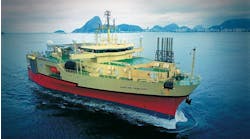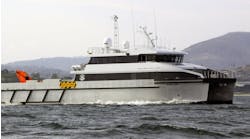Pervasive multiple reflection energy and altered seismic amplitudes continue to obscure view of the strata beneath salt structures
Dev George
Managing Editor
3D Horizon amplitude display below the salt of the Mahogany prospect, US Gulf of Mexico. [Courtesy Western Geophysical]Just a few years ago, it was virtually impossible to image substrata beneath salt structures, making exploration of some of the world's most prospective regions a very high risk activity. It wasn't that geophysicists didn't know how to do it, for they did. It was because there simply wasn't enough computer power to handle the processing and modeling of velocity. Over the past three years, however, a revolution has swept the industry - 3D seismic surveys are the exploration acquisition of choice, and the advent of ever-larger massively parallel computers has provided all the computing power needed to process the resultant seismic energy beyond the post stacked depth migrations used for above salt revelations to 3D prestacked depth migrations that reveal faulting and stratigraphy below salt.
As a consequence, enormous progress has been made that is driving subsalt exploration worldwide, but "we still haven't cracked the nut in terms of full understanding of the subsalt." We've certainly made a tremendous leap in technology, but we're still peering through a cloudy lens at a multitude of images, and we're still not able to predict hydrocarbons below salt as we can above salt. Pervasive multiple reflection energy continues to obscure our view of subsalt reflectors and seismic amplitudes, often altered drastically by wave propagation through irregular salt bodies, remain a difficult mystery to be unraveled.
Ron Chambers, geophysical advisor to the president of Western Geophysical, maintains that it is not only the amplitudes but the overall bandwidth and phase of the waveform that is altered. "When you go through a lossy medium like salt," he says, "not only do you loose the amplitude, but you also have a change in the phase of the data. Events that only go through sediment and those that only travel through salt have a different phase even though they may be reflecting the same reflector, and those that go through two passes of salt have another problem, the two cascade phenomena." (This is the Q filter that everyone talks about. Salt has a rather low q effect on the data.)
All salt bodies are lossy bodies. Their irregularity adds to the problem of scattering - the wave field actually scatters, so that's another factor added to the Q loss.
"In the days before salt," Chambers says, "we found the same kind of phenomena going through gas-filled muds - you get a change in the waveform. There are a number of different techniques for handling this phenomena, however. Up on the shelf, it's a rather simple method of applying these techniques, and its unnecessary to go through these cockeyed raypaths. And now we're studying how these methods can be extended into the more complex media. We already have the problem with the depth migration phenomena of measuring the velocity. Effectively you have to do the measurement of the Q phenomena and come up with what's going on there in a like manner.
"To do that, typically we would use normal deconvolution techniques, which effectively just work down the seismic trace, but now because we have all these bending raypaths, we have to go along the raypath rather than down the trace. Probably we're going to have to wait for the next generation of computer before we can get there, but its being studied, and its coming. In prestacked depth migrations, the multiples wind up in the wrong place, but they're still strong events and might or might not stack out, depending on how it eventually comes out.
"Typically, what we try to do, particularly in our deepwater shoots, is to try to remove the multiple with some sort of technique like Radon transformation, which is a multiple attenuation technique that images the multiple and then substracts it out. After that, you can go ahead with your depth migration. It's really an add-on rather than something the migration takes care of.
"When we do the depth migrations, typically we do them in common offset panels, and to make those work properly for multiple attenuation, they have to be very finely sampled - which means the cost goes up considerably.
"Furthermore, when you remove the multiple, you find that you've got another layer of low velocity noise coming through the salt you want to get rid of, and that turns out to be shear wave energy, because the P wave information is buried below it, amplitude wise, and it interferes with the P wave.
"If we could solve those two problems, the overall waveform and what's going on there and the multiples phenomena, we'd be going a long way toward finding the answers to subsalt imaging. There's a lot of phenomena happening out there that we don't fully understand yet.
"We're imaging things quite well, but whether they have a lot of quality as to what the image means in amplitude and phase sense, I think we're a number of years away.
A comparison of poststack and prestack 3D depth migration from the Mahogany prospect. [Courtesy Western Geophysical]
Today's successes seem to be achieved based on shape. They are more structural plays than they are stratigraphic in nature. More HCIs are found, though, by going through these various stages of processing. But they're all qualitative rather than quantitative in nature. On the shelf, we do a lot of quantitative measurements from the seismic, but right now, subsalt, we're happy to get qualitative.
Davis Ratcliff, vice president of technology at Diamond Geophysical Service agrees with Chambers, but adds that understanding how multiples manifest themselves in the time data and the depth data is critical to coming up with an approach to removing them, and understanding amplitudes below salt is a critical problem that needs further investigation. All of the significant subsalt discoveries in the Gulf of Mexico have been amplitude-related, he points out.
"Even more important, Ratcliff says, "above and beyond these two problems, is we need a much better understanding of the energy that is transmitted through the salt, because once we get a measure of what is actually happening in terms of energy transfer through the salt, that will give us a much better understanding of amplitudes and to some degree an understanding of multiples below the salt.
"The main problem that we need to address in terms of quality is a better understanding of what the raypaths are doing as they travel from the surface through the sediments, through the salt, below the salt, and then back up to the surface," he says. For that reason, Diamond Geoscience Research has been working on a research project for the last year designed to determine what these energy travel paths are doing and not doing.
"What we've found," Ratcliff says, "is that, in a conventional-type 3D approach, some places below salt are very well illuminated or very well sampled with the 3D technology, and other places are not. For example, with the conventional technique, places below salt ridges are poorly sampled or illuminated, as are the edges of salt bodies."
The Diamond research showed that by modeling the raypath distortions of a conventional shoot from a model generated from the conventional shoot, it is possible to identify those zones that were poorly illuminated and thus indicative of zones that should be reshot with a different orientation of the survey, a multi-directional 3D survey.
"We get a very good picture from a conventional work - conventional time processing, 3D time processing, plus 3D prestacked depth processing of the conventionally acquired data. Making a model from the results of that work, then shooting rays through your model, identifies the zones that were poorly illuminated, and will tell you which orientation you need to shoot in addition to what is already shot. So you need a little of the answer before you come up with the final 3D survey parameters.
"Generally speaking, some places are well sampled, others are not, and its very offset dependent - some portions of the cable record energy below salt, and some portions don't. It varies with salt geometry and salt thickness.
"Whenever you are exploring subsalt, you should not limit yourself to just the full volume stack, but should look at different offset volumes - each portion of the cable will tell you a slightly different story in terms of subsalt stratigraphy, in terms of the top and base of salt, and perhaps in terms of subsalt rock properties.Reservoir attributes plotted in a 3D volume. [Courtesy Landmark Graphics]
"Undoubtedly, this is the most important issue that needs to be addressed: a better understanding of what happens to the seismic energy as it travels through the salt. We've found we don't know what's happening. With the different salt geometry, different things happen. You change the angle of the salt, different salt thicknesses, and you can't make a prediction on how to sample the data below the salt - it effects the amplitude problem and the multiple problem.
"Once the data set is properly sampled, by way of multi-directional shooting, then you can better understand the amplitudes below salt, because the multi-directional shooting will insure a well sampled subsalt section, in terms of acquisition. In conventional shooting, we know it's not a complete picture. But no one's doing it yet. To some extent, we've been doing it a bit, with our asymmetrical spread shooting -.it's why we've shot with two boats with cables on both boats, so we could get a little more asmuthal variation. But you really need a lot more.
"One other methodology that could address the better illumination of the subsalt is vertical cable. With it, you can get a lot of asmuthal variation, a lot of different orientations of your 3D. It's one solution."
Predictions
Cross plot of seismic attributes characterize reservoir lithology. [Courtesy Landmark Graphics]
There are some operational difficulties today, but the technology for acquiring data in different orientations is available. Once the operational, logistical details are solved, which Ratcliff believes will be done in the next year or so, then we will have a well sampled section and can bring in the other types of energy, such as shear pressures. This, he feels, will be coming in the next year or two.
There are several simple approaches from deconvolution to Radon transformation multiple suppression based on models, but Ratcliff thinks care must be taken in applying these techniques in the time domain before the prestack has been done, because sometimes it is impossible to know whether we're removing multiples or primaries, since the data is in unmigrated rather than stacked position. Although it is often not being done today, the future is in application of the high tech techniques after migration, he says.
"I think in the next two years, we as an industry will develop technology that will be able to resolve subsalt stratigraphy, resolve channels beneath the salt bodies, I think we'll have a much better understanding of amplitudes below salt, and I think in the next two years, we will be in a position to use the subsalt AVO technology to predict the presence of hydrocarbons below salt. Even now we're doing subsalt AVO, and we've been able to see channels. We're on the way to making hydrocarbon predictions below salt like we do above salt."
Copyright 1996 Offshore. All Rights Reserved.







